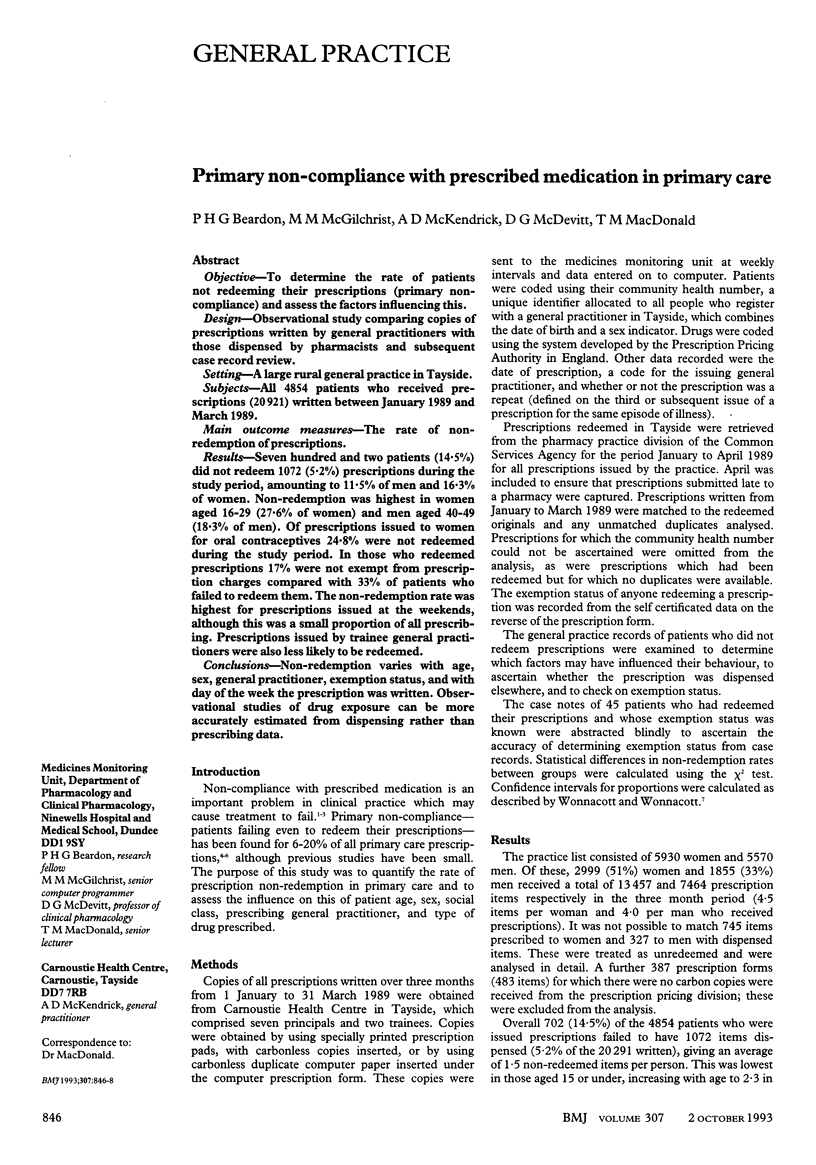Abstract
OBJECTIVE--To determine the rate of patients not redeeming their prescriptions (primary noncompliance) and assess the factors influencing this. DESIGN--Observational study comparing copies of prescriptions written by general practitioners with those dispensed by pharmacists and subsequent case record review. SETTING--A large rural general practice in Tayside. SUBJECTS--All 4854 patients who received prescriptions (20,921) written between January 1989 and March 1989. MAIN OUTCOME MEASURES--The rate of non-redemption of prescriptions. RESULTS--Seven hundred and two patients (14.5%) did not redeem 1072 (5.2%) prescriptions during the study period, amounting to 11.5% of men and 16.3% of women. Non-redemption was highest in women aged 16-29 (27.6% of women) and men aged 40-49 (18.3% of men). Of prescriptions issued to women for oral contraceptives 24.8% were not redeemed during the study period. In those who redeemed prescriptions 17% were not exempt from prescription charges compared with 33% of patients who failed to redeem them. The non-redemption rate was highest for prescriptions issued at the weekends, although this was a small proportion of all prescribing. Prescriptions issued by trainee general practitioners were also less likely to be redeemed. CONCLUSIONS--Non-redemption varies with age, sex, general practitioner, exemption status, and with day of the week the prescription was written. Observational studies of drug exposure can be more accurately estimated from dispensing rather than prescribing data.
Full text
PDF


Selected References
These references are in PubMed. This may not be the complete list of references from this article.
- Begg D. Do patients cash prescriptions? An audit in one practice. J R Coll Gen Pract. 1984 May;34(262):272–274. [PMC free article] [PubMed] [Google Scholar]
- Col N., Fanale J. E., Kronholm P. The role of medication noncompliance and adverse drug reactions in hospitalizations of the elderly. Arch Intern Med. 1990 Apr;150(4):841–845. [PubMed] [Google Scholar]
- Graham D. J., Smith C. R. Misclassification in epidemiologic studies of adverse drug reactions using large managerial data bases. Am J Prev Med. 1988;4(2 Suppl):15–24. [PubMed] [Google Scholar]
- Jick H., Jick S. S., Derby L. E. Validation of information recorded on general practitioner based computerised data resource in the United Kingdom. BMJ. 1991 Mar 30;302(6779):766–768. doi: 10.1136/bmj.302.6779.766. [DOI] [PMC free article] [PubMed] [Google Scholar]
- Rashid A. Do patients cash prescriptions? Br Med J (Clin Res Ed) 1982 Jan 2;284(6308):24–26. doi: 10.1136/bmj.284.6308.24. [DOI] [PMC free article] [PubMed] [Google Scholar]
- Waters W. H., Gould N. V., Lunn J. E. Undispensed prescriptions in a mining general practice. Br Med J. 1976 May 1;1(6017):1062–1063. doi: 10.1136/bmj.1.6017.1062. [DOI] [PMC free article] [PubMed] [Google Scholar]
- Wiseman I. C., Miller R. Quantifying non-compliance in patients receiving digoxin--a pharmacokinetic approach. S Afr Med J. 1991 Feb 2;79(3):155–157. [PubMed] [Google Scholar]


